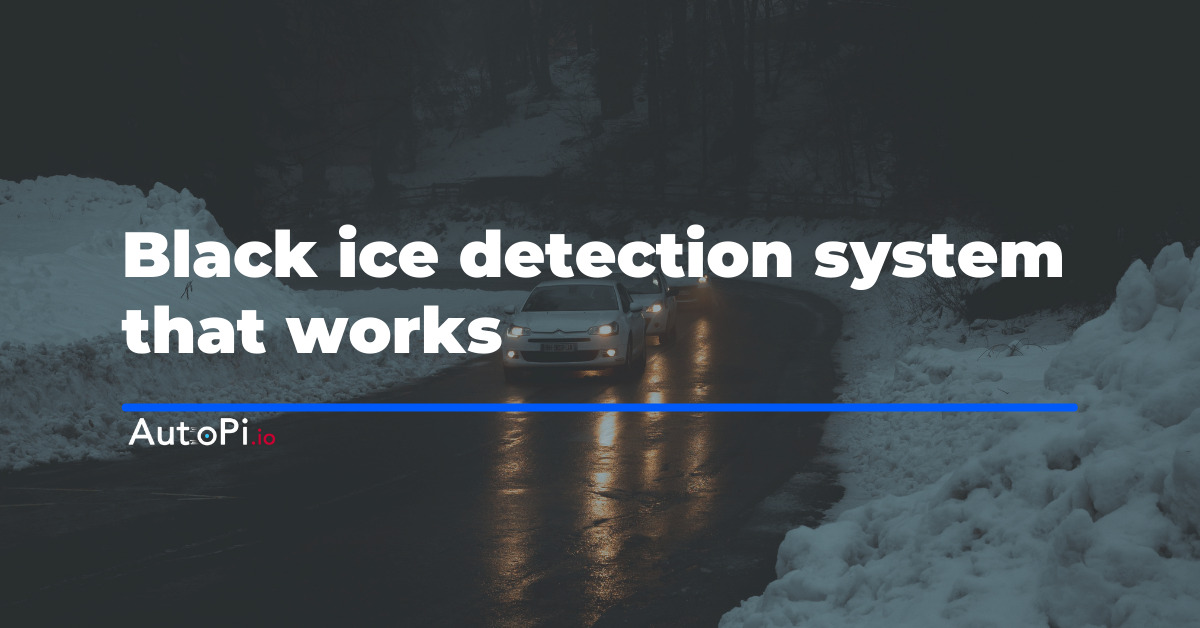Black ice is a critical hazard that affects road safety during the winter season. It forms as a nearly invisible layer of ice on the pavement when temperatures drop below freezing, especially overnight or in shaded areas. Drivers may not notice black ice until it is too late, which can lead to unexpected skidding, loss of control, and serious accidents.
Understanding how to detect black ice before it becomes a threat is an essential part of modern vehicle safety. Traditional air temperature sensors are often inaccurate due to engine heat or wind exposure. What matters most in avoiding black ice is the actual surface temperature of the road, which can be quite different from the air temperature.
Fortunately, advances in automotive IoT and sensing technology make it possible to measure road surface temperature accurately in real time. With tools like the AutoPi CAN-FD Pro and an infrared temperature sensor, drivers can receive alerts when the road surface approaches freezing conditions. These alerts allow time to reduce speed or reroute before encountering hazardous conditions.
This guide will show how to build a complete black ice detection system using AutoPi and a Phidgets infrared sensor. The system includes real-time monitoring, data logging, in-vehicle alerts, and integration with fleet platforms. Whether you're a DIY enthusiast, a developer, or a fleet manager, this solution provides a practical and scalable way to improve safety during cold weather.
What is a Black Ice Detector?
A black ice detector is useful because it assists drivers in detecting and avoiding harmful black ice on the road, thereby increasing road safety and lowering the risk of accidents and injuries. The technology employed in black ice detectors can detect black ice reliably and send real-time notifications to drivers, allowing them to slow down or modify their direction to avoid hazardous road conditions. Furthermore, black ice detectors are particularly beneficial in cold areas where black ice is more widespread, as well as at night, when it might be difficult to notice black ice on the road.
Black Ice Detection Using AutoPi CAN-FD Pro Device
Some car models have outside temperature sensors built in. These temperature sensors are meant to measure the outside air temperature but often do not give a precise reading of the air temperature because of engine heating. And when dealing with “black ice” it is more precise to know the surface temperature.
The AutoPi CAN-FD Pro device has a lot of extension possibilities through one of its ports, which makes it possible to build and extend different things. E.g., an infrared temperature sensor from Phidgets Inc:

This specific sensor can be connected directly to one of the USB ports of an AutoPi device. An infrared thermometer measures the infrared energy from an object and uses this to determine the temperature of the object (or surface). The infrared temperature sensor is mounted on the vehicle (a specific casing can be acquired for the Phidgets sensor) and set to point towards the road surface at a forward-pointing angle.

When the sensor has been installed in the vehicle, it is simply connected to the device's USB port. The AutoPi IoT platform contains a lot of possibilities to extend the temperature input from the Phidget sensor. Because all of the input and outputs in the device can be combined in a rule-based system (also known as an if-this-then-that system). Using this it is possible to build an in-car warning system using the built-in speaker in the AutoPi CAN-FD Pro device.
How the Infrared System Works
The infrared temperature sensor detects emitted thermal radiation from the road surface. It calculates the temperature based on infrared energy intensity. If the reading falls below 0°C, the AutoPi triggers a rule in the cloud dashboard to alert the driver using the built-in speaker or connected system.

Installation Guide
Mount the sensor in a forward-facing position at a 30–45° angle. Avoid wheel spray zones. Use weather shielding or casing to protect the lens and secure the USB cable inside the vehicle safely to the AutoPi unit. It’s recommended to run the sensor in a test mode first and validate sensor placement against known road conditions and temperature benchmarks.
Comparison with Other Technologies
| System | Advantages | Disadvantages |
|---|---|---|
| AutoPi + IR Sensor | Portable, low-cost, customizable rules | Limited to local surface reading |
| Road-Embedded Sensors | Fixed accuracy, central monitoring | Infrastructure cost and no vehicle-side alerts |
| Vision-Based Detection | Passive, no sensor needed | False positives in low-contrast conditions |
Logging & Data Export
Each temperature reading is logged with a timestamp and GPS position. You can view data on the AutoPi dashboard, analyze trends over time, or export to CSV or third-party software for reporting and fleet planning. Exported data can also be combined with weather APIs or road condition databases to provide predictive insights into black ice hotspots or risk zones.
Additional Considerations
Regular calibration of the infrared sensor ensures accurate surface readings across varying road materials. Emissivity settings must be fine-tuned for asphalt (typically 0.95) versus concrete or painted surfaces. In colder regions, pairing the system with a vehicle battery monitor or GPS geofencing logic can help restrict alerts to high-risk timeframes and routes. Lastly, integrating the system with external platforms via AutoPi's REST API allows fleet-wide condition alerts, scheduled check-ins, or even automated emergency notification workflows.
The AutoPi CAN-FD Pro device will record the temperature measured by the infrared temperature sensor, and based on the rules defined in the AutoPi cloud dashboard it can react to these measurements. E.g., to warn the driver by using the speaker in the CAN-FD Pro device. This can be accomplished using a cloud-based service, like Google Assistant.





